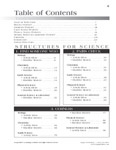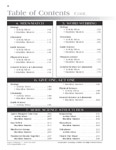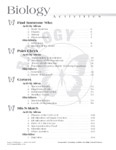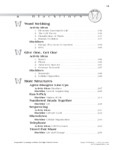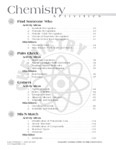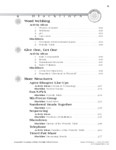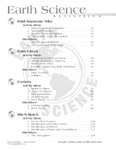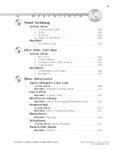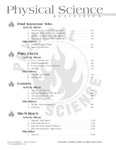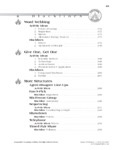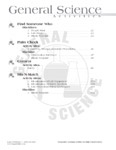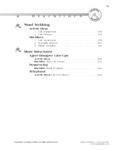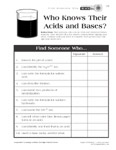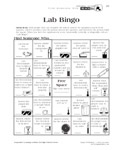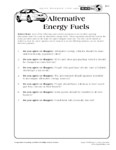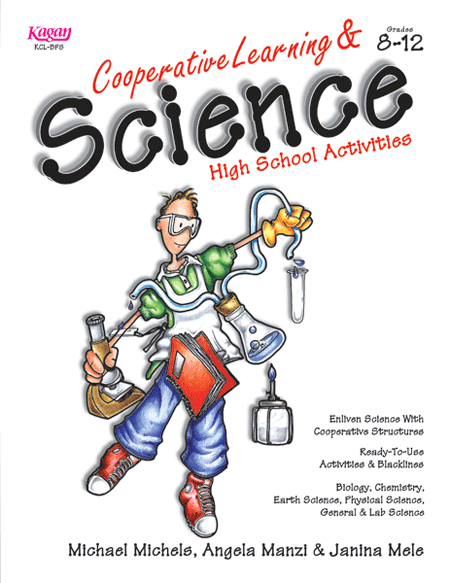
Cooperative Learning & Science
High School Activities
- Learning becomes fun using 7 Kagan Structures designed to encourage cooperation and active engagement.
- Loaded with activity ideas and blackline masters.
- Promotes teamwork, communication, and thinking in and about science.
- Spans multiple Secondary Science classes: Biology, Chemistry, Earth Science, and Physical Science.
| BFS • $34 | |
| Buy PDF eBook | |
Learning science content has never been so fun and interactive. This book features Kagan Cooperative Learning Structures such as: Find Someone Who, Pairs Check, Corners, Mix-N-Match, Word-Webbing, and GiveOne–GetOne to make science learning motivating and memorable. You'll find loads of age-appropriate activity ideas and ready-to-use blackline masters for each of the following science classes: Biology, Chemistry, Earth Science, Physical Science, and General and Lab Science. Your secondary science class will be humming with excitement and interest. 280 pages.
Sample Pages
Click on an image to view and/or print it full size.
To make science content fun and interactive for Grades 8-12, this book features Kagan Cooperative Learning Structures such as RallyRobin, Find Someone Who, Pairs Check, Mix-N-Match, and Give One, Get One. Page after page of age-appropriate activity ideas and ready-to-use blackline masters make science learning motivating and memorable for biology, chemistry, earth science, physical science, and general and lab science. High school (and advanced middle school/junior high) science classes will hum with excitement and interest.
SUMMARY
Cooperative Learning and Science: High School Activities, by Michael Michels, Angela Manzi and Janina Mele, specifically outlines how cooperative learning methods may help secondary students understand such science concepts as the periodic table, the layers of the earth, the difference between speed and velocity, macromolecules, and the nature of a DNA helix.
Cooperative learning is booming at the secondary school level after thriving for many years at the elementary level. A large scale meta-analysis (Johnson et al., 1981) revealed similarly large, consistent gains in academic and social variables when cooperative learning was used with high school students as with elementary school students, across hundreds of research studies. Today, demand for cooperative learning trainings and resources among high school and college professors rivals the demand among elementary school teachers. High school (and advanced middle school/junior high) teachers respond with unbridled enthusiasm: "Finally a workshop just for me!"
Cooperative Learning and Science offers activity ideas and ready-to-use blackline masters so that teachers no longer need to re-invent generic cooperative learning materials. The authors adopt Dr. Spencer Kagan's instructional approach to cooperative learning. Dr. Kagan is known worldwide for distinguishing what teachers teach from how they teach. He contrasts a curricular approach that would treat science topics as an explicit curriculum – and demand that teachers develop new presentations of scientific content – against his instructional approach, which would treat the scientific method as a process that students can master. Following Dr. Kagan's lead, Michels, Manzi and Mele make it clear to science teachers how they may teach existing topics using new instructional strategies that foster scientific thinking. These instructional strategies are called structures.
Kagan Structures are content-free sequences of rule-based student interactions. As the name structures indicates, these sequences literally structure students' interaction with each other, and/or with the content, and/or with the teacher. RallyRobin™ is one of the simplest of over two hundred Kagan Structures. It can be used with no preparation and no change in content, at almost any point in a lesson. In brief, the rules for RallyRobin tell students to work in pairs and take turns speaking, usually recalling or generating ideas, such as possible alternative explanations for a scientific phenomenon.
While these structures increase student engagement for any subject across the curriculum, they embed a particularly important proposition into science lessons: Learning to work in teams is particularly vital to science. The independent worker may remain the norm in the traditional realm of the Humanities, but 21st century science depends on interdependent teams, often in different locales, coordinating their efforts toward a shared goal. Likewise, the teacher discovers, after using RallyRobin or any other structure just a few times, that it is easy to use the structures repeatedly to generate new activities for any science topic.
FROM THE FOREWORD BY DR. SPENCER KAGAN
"Michael Michels, Angela Manzi, and Janina Mele have made an important contribution to the process of releasing the power of cooperative learning in high school classrooms. With Cooperative Learning and Science, any high school science teacher will find ready-made, proven activities."
"As science continues to build on the complex methodologies and findings that are being established, interdependence among scientists will become even more the norm and teamwork skills will be prerequisite for full participation in the scientific community."
"The book should come with a warning label: Caution Advised. Use of the Enclosed Activities Is Likely to Lead to an Addiction! All it will take is trying a few of these activities in your own classroom and observing the reaction and performance of students, and you will get hooked."
AUTHOR BIOS
Michael Michels attended Rutgers University, New Brunswick, N.J., and attained a Bachelor of Science degree in Plant Science with a specialization in High School Science Teaching in 1998. He achieved his Masters of Science degree in Educational Technology at Ramapo College, Mahwah, N.J., in 2002. Since 1999 he has taught Biology, Physical Science, Horticulture and Chemistry at Indian Hills High School in Oakland, N.J. Michels has been utilizing Kagan's Cooperative Learning Structures in class since 1999.
Angela Manzi earned a Bachelor of Science degree in Marine Science with a specialization in Secondary Science Education from Richard Stockton College, Pomona, N.J., in 1994. She received her Masters of Science in Biology from Montclair State University, Montclair, N.J., in 2002. Since 1995 she has taught Biology, Horticulture and Chemistry at Indian Hills High School in Oakland, N.J. Manzi is actively involved in the planning and implementation of professional development activities in the Ramapo Indian Hills Regional High School District. She has incorporated Kagan's Cooperative Learning Structures into her classroom repertoire since 1995.
Janina Mele achieved her Bachelor of Arts degree in Secondary School Sciences and her Master of Arts degree in School Social Work and Student Services from William Paterson University, Wayne, N.J. She is an Adjunct Professor at The College of New Jersey, in affiliation with The Regional Training Center in Randolph, N.J. She is also is employed as a Trainer for Kagan Professional Development, of San Clemente, Calif., and a Trainer/Consultant for The Write Track, of Suffern, N.Y. In 2001 Mele retired after serving 25 years as a Biology and Chemistry teacher at Indian Hills High School in Oakland, N.J., where she was an active participant in many phases of staff development and an advocate of Cooperative Learning.
Back

